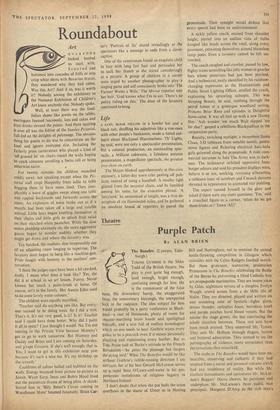Theatre
Purple Patch
By ALAN BRIEN burgh.)
TYRONE (itratale is the Mike Todd of the British theatre. No play is ever quite big enough, loud enough, bright enough, confusing enough for him. He is the connoisseur of the false nose, the dromedary hump, the exaggerated limp, the unnecessary hiccough, the unexpected kick in the codpiece. The idea subject for him Would probably be a party conference at Black- Pool—a cast of thousands, plenty of room for counter-marching brass bands and spotlighted fisticuffs, and a text full of endless monologues which no one needs to hear. Guthrie wants every goose to be a peacock even if it means personally plucking and repinioning every feather. But as Torn Paine said of Burke's attitude to the French Revolution—`he pities the plumage but forgets the dying bird.' What The Bonefire would be like without Guthrie's rabble-rousing direction I am not sure, for at his best Gerard McLarnon serves up a tepid Sean O'Casey-and-water in his pre- posterous melodrama of religious bigotry in Northern Ireland.
I don't doubt that when the pot boils the scum overflows in the slums of Ulster as in Notting Hill and Nottingham, not to mention the arm bottle-throwing competition in Glasgow whi coincides with the Celtic-Rangers football mat( But these grotesque, scarecrow, proletari Protestants in The Bonefire celebrating the Bat of the Boyne by pulverising a blind Catholic b are propaganda marionettes. They are insane joi by Giles, nightmare terrors of a sleepless Evel Waugh, crowd scenes from a de Mille life Stalin. They are directed, played and written one niounting note of hysteria—lights gla drums thunder, epileptics foam, harridans ho and purple patches burst blood vessels. But t noisier the stage grows, the less convincing t whole situation becomes. These riot acts ha been much praised. They unnerved Mr. Tyna They sent Mr. Hobson through disgust, horr and battered admiration. They seemed to me t pornography of violence, more sensational th the sensations they mimicked.
The mobs in The Bonefire would have been u bearable, unnerving and cathartic if they h erupted from a social and personal volcano whi had any semblance of reality. But while Iv Guthrie fantasticates and caricatures Mr. McL: non's Beggars' Opera chorus, he paralyses al underplays Mr. McLarnon's three stolid, ni principals. Margaret D'Arcy as the rich mar daughter looks and •moves and enunciates like a suburban tennis club secretary—yet her dialogue is windy with half-digested poeticisms. Their con- flict is never reconciled, or even acknowledged, and I could not accept her brief, carefully planned affair with the Catholic sailor, her be- trayal of him to the Protestant mob, and then their final suicide pact to commit suttee on the celebratory bonfire. Nor is there any textual eluci- dation of why an unenthusiastic Catholic should suddenly burst out like Savonarola or an unen- thusiastic Protestant suddenly play Titus Oates. Here, surely, Mr. Guthrie's immense talents for bringing the dead drama to life would have saved the play. Instead he lets them play these incredible scenes as if they were part of a poetry reading. For once in a Tyrone Guthrie production we hear every word. And we regret it.
Between raising Cain in the mob and injecting novocaine in the lovers Mr. Guthrie and Mr. McLarnon together contrive some small but effective scenes of pathos and despair as the violence ebbs and humanity begins to feel its wounds. But they are not enough to save the evening or to make The Bonfire worthy of an international Festival.



































 Previous page
Previous page